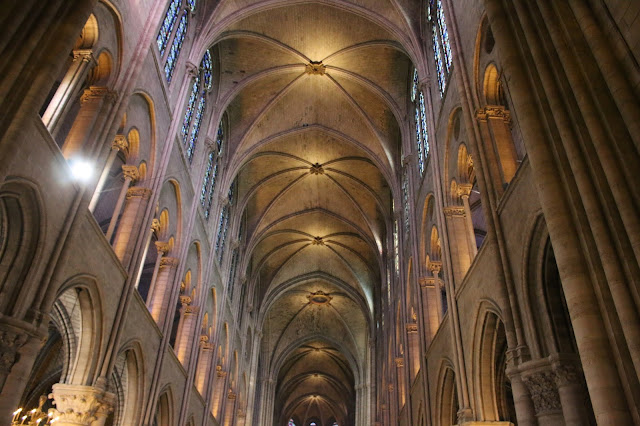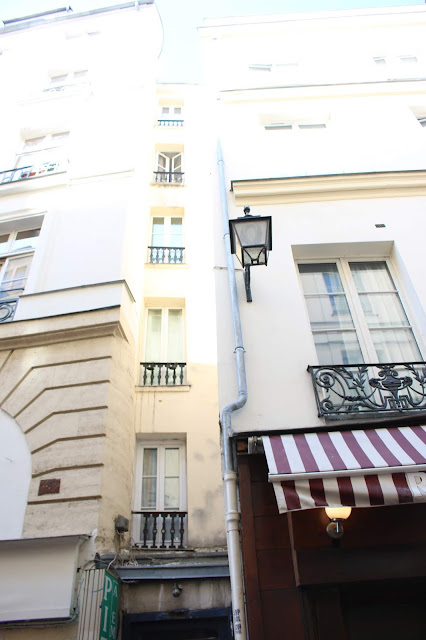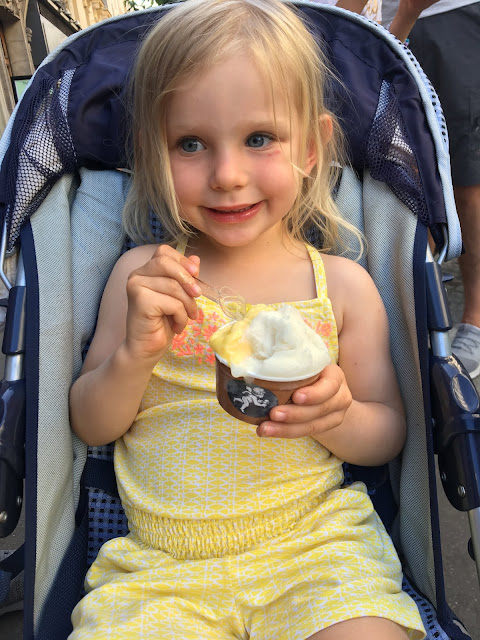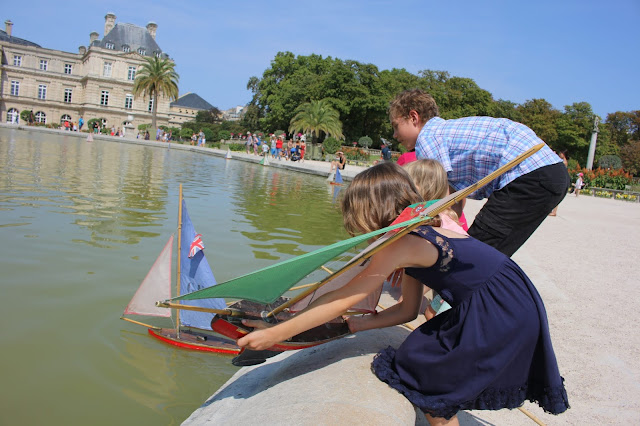Paris - the City of Light
Bienveneu! We have chosen well this year! France is Europe's most diverse, tasty, and, in many ways, most exciting country to explore. We spent one week in Paris and another week in Amboise, exploring the beauty of Loire Valley.
The church is dedicated toto "our Lady" (Notre Dame), and there she is, cradling God, right in the heart of the façade, surrounded by the halo of the rose window.
We are standing at the center of France, the point from which all distances are measured. It was also the center of Paris 2,300 Years ago, when the Parisii tribe fished where the east-west rived crossed a north-south road. The Romans conquered the Parisii and build their Temple of Jupiter where Notre-Dame stands today.
Pure Gothic: pointed arches, the lacy stone tracery of the windows, pinnacles, statues on rooftops, a lead roof, and a pointed steeple covered with the prickly "flames" of the Holy Spirit. But most distinctive of all are the flying buttresses.

Strolling through Ile St. Louis, a romantic and peaceful neighborhood hoping to savor some of the famous les glaces Berthillion - ice cream. Unfortunately for us, many businesses and restaurants are closed in August and that was the case with the Berthillon shop. Bummer!
And a nice lunch at Les Fous de I'lle - a fun place to eat bistro fare with gourmet touches.
St. Severin church where we found a refuge from a very busy and touristy part of the city. Don't ask me why, but building this church took a century longer than building Notre-Dame.
It's notable for carrying on the medieval tradition of stained-glass windows into more modern times, while keeping the dominant blues, greens, and reds popular in St. Severin's heyday.
Sainte-Chapelle. The triumph of Gothic church architecture is a cathedral of glass like no other. It was built for King Louis IX to house the supposed Crown of Thorns (now kept at Notre-Dame and shown only on Good Friday).
Fiat lux. "Let here be light." From the first page of the Bible, it's clear: Light is divine. Light shines through stained glass like God's grace shining down to earth. The glory of Gothic shines brighter here than in any other church I have seen. There are 15 separate panels of stained glass with more than 1, 100 different scenes, mostly from the Bible.
The altar was raised up high to better display the Crown of Thorns, the relic around which this chapel was built. King Louis IX, convinced he'd found the real McCoy, spent roughly the equivalent of 500 million euros for the Crown, about 370 million euros for the gem-studded shrine to display it in, and a mere 150 million euros to build Sainte-Chapelle to house it. Gulp!!!
Construction of the 165-foot-high arch began in 1809 to honor Napoleon's soldiers, who, despite being vastly outnumbered by the Austrians, scored a remarkable victory at the Battle of Austerlitz. Patterned after the ceremonial arches of ancient Roman conquerors, it celebrate Napoleon as emperor of a "New Rome".
Place de la Concorde. During the Revolution, this was the Place de la Revolution. The guillotine sat on this square, and many of the 2.780 people who were beheaded during the Revolution lost their bodies here during the Reign of Terror. The 3,300-year-old, 72-foot, 220-ton, red granite, hieroglyph-inscribed obelisk of Luxor now forms the centerpiece of Place de la Concorde.

This day we sl-o-o-owed down. We began with a nice stroll through a peaceful neighborhood with chatty crepe stands, chic boutiques and MANY sidewalk cafes, had a lovely lunch at an organic creperie and later in the day stepped into an Impressionist painting in a tree-lined park.
Then we stepped into St. Sulpice church. It has a remarkable organ and Delacroix's three murals of fighting angels. The most famous is the agitated Jacob Wrestling the Angel.
What's the best pastry shop in Paris? According to local shopkeepers, it's Gerard Mulot's patisserie. That's saying a lot. We ogled the window display and then tried some of the creations -oh, baby!!!

Four children, five small carry -on suitcases, an appetite to understand and a willingness to experience. And above all, one big God!
Paris has been the cultural capital of Europe for centuries. And we started where it did on Ile de a Cite on a walk that laces together 80 generations of history - from Celtic fishing village to Roman city, bustling medieval capital, birthplace of the Revolution, bohemian haunt of the 1920's café scene, and the working world of modern Paris. Along the way, we stepped into two of Paris' greatest sights - Notre-Dame and Sainte-Chapelle.
Our dear German friends Thomas, Katja and their daughter Charlotte spent first three days with us in Paris. Charlotte and Sofia have been inseparable friends for two years. And we seem to make it happen for them!
The church is dedicated toto "our Lady" (Notre Dame), and there she is, cradling God, right in the heart of the façade, surrounded by the halo of the rose window.
The church is massive and imposing, yet graceful.
We are standing at the center of France, the point from which all distances are measured. It was also the center of Paris 2,300 Years ago, when the Parisii tribe fished where the east-west rived crossed a north-south road. The Romans conquered the Parisii and build their Temple of Jupiter where Notre-Dame stands today.
Pure Gothic: pointed arches, the lacy stone tracery of the windows, pinnacles, statues on rooftops, a lead roof, and a pointed steeple covered with the prickly "flames" of the Holy Spirit. But most distinctive of all are the flying buttresses.

Terribilis est locus iste…"This place is terribilis," meaning awe - inspiring or even terrifying. It's a huge, dark, earthly cavern lit with an unearthly lights. This is Gothic.
Here along the riverbank, the "big business" is secondhand books, displayed in the green metal stalls on the parapet.
The children found good deals on souvenirs.
And just a few steps from busy Notre-Dame, one can find a small park with roses, benches, a water fountain and virtually NO tourists to pause, refresh, and take a breath to realize how blessed you are to spend such a nice day with precious family and great friends.
And a nice lunch at Les Fous de I'lle - a fun place to eat bistro fare with gourmet touches.
St. Severin church where we found a refuge from a very busy and touristy part of the city. Don't ask me why, but building this church took a century longer than building Notre-Dame.
It's notable for carrying on the medieval tradition of stained-glass windows into more modern times, while keeping the dominant blues, greens, and reds popular in St. Severin's heyday.
Sainte-Chapelle. The triumph of Gothic church architecture is a cathedral of glass like no other. It was built for King Louis IX to house the supposed Crown of Thorns (now kept at Notre-Dame and shown only on Good Friday).
Fiat lux. "Let here be light." From the first page of the Bible, it's clear: Light is divine. Light shines through stained glass like God's grace shining down to earth. The glory of Gothic shines brighter here than in any other church I have seen. There are 15 separate panels of stained glass with more than 1, 100 different scenes, mostly from the Bible.
The altar was raised up high to better display the Crown of Thorns, the relic around which this chapel was built. King Louis IX, convinced he'd found the real McCoy, spent roughly the equivalent of 500 million euros for the Crown, about 370 million euros for the gem-studded shrine to display it in, and a mere 150 million euros to build Sainte-Chapelle to house it. Gulp!!!
And here she is! The Eiffel Tower. It's crowded, expensive, and there are probably better views in Paris, but visiting is unforgettable. This is a once-in-a-lifetime, I've -been-there experience. We rode all the way to the top and stayed until it got dark to see the lights. The views were grand!
Delicate and graceful when seen from afar, the Tower is massive - even a bit scary - close up. The tower, including its antenna, stands 1, 063 feet tall. Its four support pillars straddle an area of 3,5 acres. Despite the tower's 7,300 tons of metal and 60 tons of paint, it is so well-engineered that it weights no more per square inch at its base than a linebacker on tiptoes.
A royal trip to Versailles. This was a day that showed that sometimes I can really make demands on my family when travelling - and they can rise to an occasion! Visiting Versailles can seem daunting because of its size and hordes of visitors. And even with a pass and other crowd beating tips, we ended up waiting 3 hours in a line just to get into the Chateau. Actually, Tim, our hero, waited in a line while we explored the gardens and rested in a shade.
And once we finally got in the Chateau, we walked through dozens of lavish, chandeliered rooms once inhabited by Louis XIV and his successors.
The Hall of Mirrors. No one had ever seen anything like this hall when it was opened. The hall is nearly 250 feet long. Imagine this place lit by the flames of thousands of candles filled with ambassadors, nobles, and guests dressed in silks and powdered wigs. At the far end of the room sits the king, on the canopied throne.
There is so much more to see in Versailles but with no energy left, we decided to save the rest for next time.
The next day after saying goodbye to our friends we visited Army Museum and Napoleon's Tomb.
Europe's greatest military museum, in the Hotel des Invalides, provides interesting coverage of several wars, particularly World Wars I and II.
At the center of the complex, Napoleon lies majestically dead inside several coffins under a grand dome, which glitters with 26 pounds of thinly pounded gold leaf.
The complex is huge and we chose to stroll through World War I and II exhibits which were excellent.
Paris' excellent bus system was worth figuring out. Buses required less walking and fewer stairways than the Metro and we saw Paris unfold as we traveled.
The next stop:
Champs-Elsees Walk from the Arc de Triomphe to Place de la Concorde
Construction of the 165-foot-high arch began in 1809 to honor Napoleon's soldiers, who, despite being vastly outnumbered by the Austrians, scored a remarkable victory at the Battle of Austerlitz. Patterned after the ceremonial arches of ancient Roman conquerors, it celebrate Napoleon as emperor of a "New Rome".
From the top we had an eye-popping view of tout Paris. Gazing at he home of 11 million people, all crammed into an area the size of an average city in the US!
Today, the Arc de Triomphe is dedicated to the glory of all French armies.
Champs-Elysees. This is Paris at its most Parisian:monumental sidewalks, stylish shops, elegant cafes, glimmering showrooms, and proud Parisians on parade. The whole world seems to gather here to strut along the boulevard.
We stopped for lunch at a peaceful café inside breathtaking building Petit Palais, which has a pleasing permanent collection of lesser painting by Coubert, Monet, Pissarro, and other 19th-century masters.
.
Place de la Concorde. During the Revolution, this was the Place de la Revolution. The guillotine sat on this square, and many of the 2.780 people who were beheaded during the Revolution lost their bodies here during the Reign of Terror. The 3,300-year-old, 72-foot, 220-ton, red granite, hieroglyph-inscribed obelisk of Luxor now forms the centerpiece of Place de la Concorde.

Hotel Crillon, one of Paris' most exclusive hotels. This hotel is so fancy that one of its belle epoque rooms is displayed in New York's Metropolitan Museum of Art.
Place de la Madeleine. Looking like a Roman teple with fifty-two 65-foot Corinthian columns. Designed as a secular temple to honor Napoleon's army, it became a church in 1842; today it's used as both a church and concert venue.
During Chopin's funeral, in 1849, 3,000 mourners packed this church as musicians played the famous dirge of Chopin's Funeral March.
And we saw a wedding while visiting.
Montmartre. Paris' highest hill, topped by Sacre-Coeur Basilica, is best known as the home of cabaret nightlife and bohemian artists. We fueled with gelato before climbing the hill.
The Sacre-Coeur is impressive an iconic with its onion domes and bleached-bone pallor, it looks ancient, but it was finished only a century ago. It stands on a foundation of 83 pillars sunk 130 feet deep, necessary because the ground beneath was honeycombed with gypsum mines. The exterior is laced with gypsum, which whitens with age.
Nice! No cleaning needed!
And we finished our busy day with a nice big dinner of steak and potatoes! Yum!
This day we sl-o-o-owed down. We began with a nice stroll through a peaceful neighborhood with chatty crepe stands, chic boutiques and MANY sidewalk cafes, had a lovely lunch at an organic creperie and later in the day stepped into an Impressionist painting in a tree-lined park.
The Pantheon
Neoclassical monument and burial place of the famous.
The Luxembourg Garden
(Jardin du Luxembourg)
This lovely 60-acre garden is an Impressionist painting brought to life.
We slipped into a green chair pondside, enjoyed the radiant flower beds and watched our children sail toy sailboats.
This is France. The serious business of eating.
Superb foie gras and desserts.
A perfect end to a perfect day.
Our last day in Paris we did a little Left Bank shopping stroll with many stops to eat.
First, we found Paris' most celebrated bread-beautiful round loaves with designer crust- at Poilane bakery. We also tried their buttery pastries. One of the best we had in Paris.
Then we stepped into St. Sulpice church. It has a remarkable organ and Delacroix's three murals of fighting angels. The most famous is the agitated Jacob Wrestling the Angel.
What's the best pastry shop in Paris? According to local shopkeepers, it's Gerard Mulot's patisserie. That's saying a lot. We ogled the window display and then tried some of the creations -oh, baby!!!
A nice lunch at a lovely creperie. Knowing this might be our last crepes in Paris, we ate a lot.
This is what happens when you eat too much food!
And we ended up our Paris trip with an one-hour boat cruise on the Seine.

We love you forever, Paris!





































































































































































Comments
Post a Comment